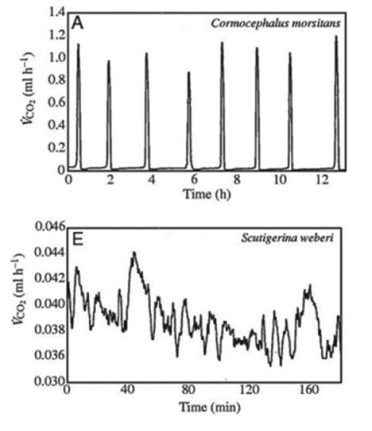Many terrestrial arthropods exchange gases with their environments by using tracheae, tubes that lead from openings (called spiracles) in the animal's exoskeleton or cuticle directly to the animal's tissues. Some arthropods can control whether their spiracles are opened or closed; opening the spiracles allows the carbon dioxide produced in the tissues to travel down the tracheae and be released outside the animal. Klok et al. measured the carbon dioxide emitted over time (represented by VCO₂) by several species of centipedes. The figures present graphs of their results for two species, Cormocephalus morsitans and Scutigerina weberi. (C. J. Klok, R. D. Mercer, and S. L. Chown. 2002. Discontinuous gas-exchange in centipedes and its convergent evolution in tracheated arthropods. Journal of Experimental Biology 205:1019-29.) Copyright 2002 The Company of Biologists and the Journal of Experimental Biology. 
Look at the graph for Scutigerina weberi (note the scale of the y-axis) in the figure.
- What is the best interpretation of these results?
Definitions:
Q1: Which of the following cells transport sugars
Q19: The secondary mesophyll of leaves is made
Q24: Epiphytes are<br>A) fungi that attack plants.<br>B) fungi
Q25: A student encounters an animal embryo at
Q27: Which of the following are important components
Q31: A large seaweed that floats freely on
Q32: Predict the results if the researchers had
Q40: Both animals and fungi are heterotrophic. What
Q41: Before ploughing a paddock, a farmer thought
Q52: Which of the following are problems associated